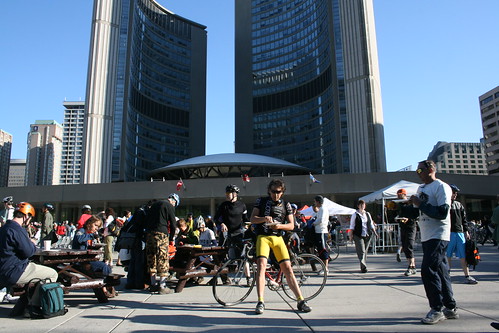
Emotions were high as Bike Month kicked off yesterday. Thousands of cyclists joined mayor David Miller in commuting to an early morning pancake breakfast held in Nathan Phillip’s Square. But pancakes weren’t enough to dissuade Denzil Minnan-Wong and other councillors pulled out all the stops to delay a vote simply to approve the Jarvis Street Streetscape Improvements Environmental Assessment Study.
Before I get into some of the highlights of the seven and a half hour marathon discussion, I want to go over what was being decided upon, for if anything was lost in the day-long debate, it was the relatively modest and straightforward proposal itself.
What was at stake today was approving the recommendations of an environmental assessment on the Jarvis Street Streetscape Improvement proposal. The assessment was unanimously in support of closing the fifth reversible lane on Jarvis Street. It stated that narrowing the street from five lanes to four would have a minimal impact on car trips along the stretch from Bloor Street to Queen Street (a maximum of 2 minutes extra at peak times during rush hour).
This being said, the underlying purpose of the study was to look at ways to help Jarvis Street reclaim some of its former glory as one of the city’s finest boulevards. Several alternatives were proposed as ways of rejuvenating the stretch, the one chosen being the expansion and improvement of the sidewalk along with the addition of two bike lanes going north and south respectively.
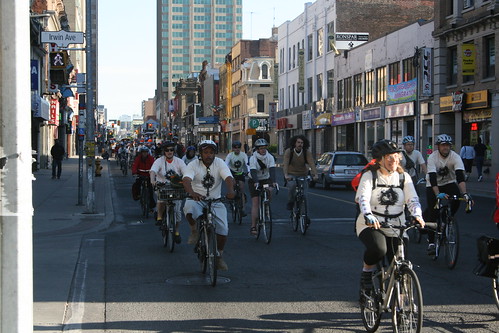
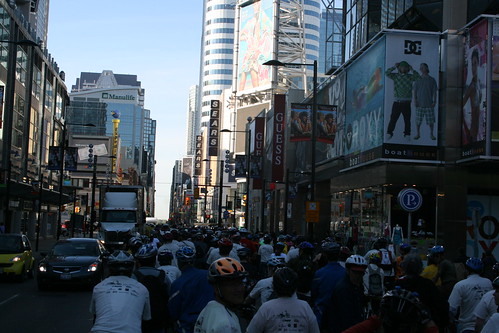

For seven and a half hours, councillor Minnan-Wong along with councillors Stintz, Holyday, Thompson, Del Grande, Ootes, Jenkins, Parker, Ford, Shiner, Walker and others relentlessly confused the issue at stake. They argued that bike lanes were unnecessary for Jarvis Street and that this meant that so too was the car lane reduction. In other words, the car lane reduction was just another example of the city’s supposed “war on the car†(as Del Grande put it) if favour of the bike.
The shift in focus from the study itself to bike use in Toronto quickly polarized the room, which in the morning was filled with helmet-wearing cyclists fresh from the opening ceremonies of Bike Month held outside. Minnan-Wong’s assertion that the Don Valley bike path and St George Street bike lanes (George Street, as he called it) were good enough didn’t help much. Nor did Holyday’s comment lighten the mood when, with around a hundred helmet clad cyclists in the room, he boldly stated that “I’ve talked to lots of people who live where the bike lanes are, and there’s nobody in them. Nobody.â€


Frustrations boiled over at 5:30pm when councillor Ford, a self-proclaimed “straight talker,†upset the whole chamber by bluntly declaring that “bikers are a pain in the ass.â€
The underlying premise of the proposal, to rejuvenate the neighbourhood surrounding Jarvis Street, was totally forgotten. As councillor Vaughan pointed out, the improvements don’t signify a “war on the car†but “a war on past mistakes.†The proposal is an attempt to rectify the planning decisions of the 1940s and 50s that “murdered†one of Toronto’s most beautiful neighbourhoods by prioritizing car travel at the expense of all other forms of mobility.
Of the $6 million going towards these improvements, only $50,000 to $100,000 will likely be used to put in bike lanes. The rest will go to beautifying the street for pedestrian users with trees, historic plaques and new wider sidewalks.
Furthermore, as councillor Mihevc pointed out, motorist transit will actually improve by partially dedicating one lane to cyclists. Although slightly counter-intuitive, expanded sidewalks and a safer bike route will actually make car transit more efficient by reducing the number of cars on Jarvis Street in the long run. This will occur following the anticipated “modal shift†that will occur as new transportation alternatives are made available by the street improvements.
The real turning point came when councillor Cho, who had begun the day arguing against narrowing Jarvis, decided to throw his support behind the proposal. “We owe it to our children,†Cho remarked, emphasizing the environmental benefits of cycling over polluting motor vehicles.
“We have all won,†said councillor Rae following the 28-16 vote passing the study reccommending bike lanes and improved sidewalks. “The whole city has won. We have made the street more complete for bicyclists, for car drivers, for transit users and for pedestrians: for everyone.â€
photos by Jake Schabas


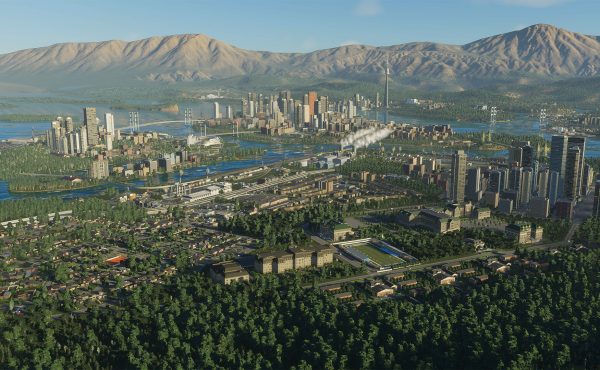
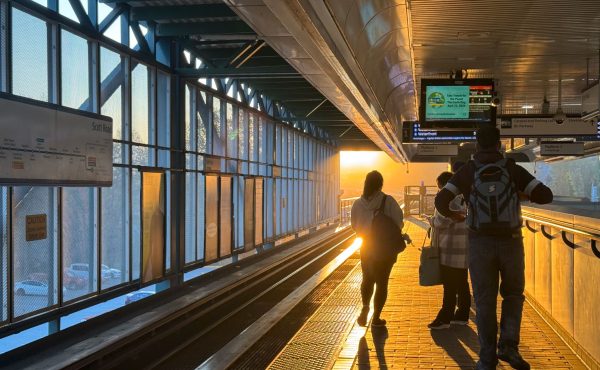
31 comments
Hi, Jake,
in fairness to Holyday, I believe he was referring to some bike lanes in his ward, somewhere in Etobicoke. It is possible that some of those starting-nowhere-going-nowhere bike lanes are underused.
Also I believe the approved plan does not include “wider sidewalks”.
I see this as a second-best result. Wider sidewalk on Jarvis makes more sense, bike lane should be on Church.
Thanks for attending, and for the writeup. Quick Q: my councilor, Cliff Jenkins — usually a fairly reasonable guy — opposed the motion. You mentioned he was among those who “relentlessly confused the issue at stake.” Any recollection of what he said?
I don’t know why these folks keep bringing up the point that bike lanes aren’t used in various parts of the city. That is precisely the point of projects such as this one and more importantly the proposed Bloor/Danforth bike lane. Bike lanes starting and ending in nowhere are unlikely to be used by folks trying, for example, to get downtown from say Keele and Steeles.
Certainly these folks would understand why we had no subway ridership if we had the subway in several pieces scattered around the area with only 1-2 stops each (e.g. Jane to Old Mill, Summerhill to Eglinton, Finch to York Mills, and Vic Park to Kennedy with no service between). Would they be arguing against connecting those pieces saying that nobody rode the subway we had?
Probably.
Yu, I completely agree with you that there are likely bike lanes in Etobicoke that are currently underused, probably partly due to the patchy state of the bike plan, which isn’t due to be finished for another few years. But Holyday made it clear that he was referring to bike lanes all around the city. I didn’t even mention his comment on TTC bike racks, which in his opinion are a “waste of money” that he has supposedly never seen used.
Hi Andrew. Jenkins spoke several times during the day, first as one of the early questioners of mayor Miller. He challenged Miller on the cost of the bike lanes, which he at first assumed would be in the millions of dollars (rather than $50-100K). He then asked why we should wait for the bike lane to rejuvenate Jarvis street? Miller responded that the bike lanes are actually relatively easy to install and could be finished by the end of this year. It is the streetscape beautification improvements that will take an estimated three years to complete.
I’m a very big cycling advocate, but it seems the whole Jarvis deal was only put in the spotlight to polarize everyone. It’s certainly not a critical addition to the bike network, as a nearby alternative exists.
Now if it was about Bloor-Danforth lanes, that would be a debate worth having.
Hi, Jake, I was there when he spoke and I had different impression. Never mind, not a big deal. Actually I think he made a good point, why are we adding these piecemeal bikelanes without really connecting them into a network that can take you somewhere? Really, a center piece for such a network should be Bloor-Danforth (of course I’d imagine when he said the city should build a network to test if it was useful, Bloor was not what he had in mind). Forget about Jarvis, IMHO it is a rather insignificant addition to cycling infrastructure, go all out for Bloor, that is the real thing we need.
Although I applaude the decision to remove one of five lanes for another purpose, I fear it won’t result in a transformation of Jarvis Street that many were hoping for. The pavement will be the same width and the only difference for pedestrians is what will happen on the sidewalks which will remain the same width. No widening for additional trees, little additional buffer from cars. Bike lanes are good, but not enough.
The real loser here is the pedestrian, not northern commuters. They will still have two lanes to travel in for each direction during rush hour. Boo hoo. Why should Jarvis be more accomodating for cars than any other downtown street with off-peak parking? Just because it connects to the north? Queen, King, Dundas, College, the list goes on–all four lanes wide with off-peak in the demand directon.
Stop being so bloody selfish. If anyone was planning a 5-lane road through their neighbourhood to handle commuters from further north than themselves, they’d scream murder. But no, its downtown and those neighbourhoods don’t count. If you want to live further away from where you work, deal with it and take transit like eveyone else who can’t afford Moore Park. At least now you’ll be able to bike down the hill and get some exercise.
yu: FYI, Holyday is a broken record on the “no-one uses bike lanes” thing (see for example this Star article from December: http://www.thestar.com/News/GTA/article/552036). I contacted him after that article and said (I’m paraphrasing here) “I use those bike lanes daily in Etobicoke, and I see other people using them too”, but he won’t let it go.
Good to see a national organization is watching TO’s bike plans.
– – – – –
Bicycle Trade Association of Canada applauds Toronto’s bold new bike move
(May 26, 2009 – Toronto) Last night, Toronto City Council approved a plan to turn part of Jarvis Street into a bike path.
Cycling advocates all over the city hailed the initiative as an important step towards making Toronto a more bike-friendly city.
Toronto city councilors voted 28-16 in favour of eliminating one of Jarvis Street’s five lanes and adding two bike lanes, which will run from Bloor Street to Queen Street.
‘We’re thrilled with the decision,’ said Janet O’Connell, Executive Director of the Bicycle Trade Association of Canada (BTAC). ‘We need to be looking at ways to facilitate cycling as a mode of transportation – it’s ecologically friendly, economical and healthy. Other cities around the world are becoming more bike-friendly, because it make sense. Toronto needs to do the same and this is a step in the right direction.’
O’Connell points to London, England as an example. The British capital, notorious for its traffic problems, has made cycling a priority and is reaping the benefits. Daily bike trips into the city have risen to 545,000, a 9% increase over last year. 111 million pounds of the 2009 budget are earmarked for various cycling infrastructure projects, including 66,000 new parking spaces.
‘Governments – federal, provincial and municipal – need to acknowledge the importance of alternate transportation,’ O’Connell added. ‘Bikes are becoming more and more common, and that’s a positive thing – they’re the greenest, healthiest vehicles we have. But the appropriate infrastructure needs to be provided for cyclist to safely share the road with motorists.’
“The pavement will be the same width and the only difference for pedestrians is what will happen on the sidewalks which will remain the same width. No widening for additional trees, little additional buffer from cars. Bike lanes are good, but not enough.”
Hmm, the bike lanes will be a buffer. Still need more trees, and hopefully not where a bike will clip them.
Ed: How will 1.8m of asphalt be a buffer? It creates less of a separation than a row of parked cars. It’s not like people drive inches from the curb anyway. The best buffer is space, with something in it. Unless there is a parade of cyclists everyday, I can’t see how that would happen. The better use of that space would have been to improve the landscape, fulfilling the original intent of the improvement project. I’m not against cycling lanes at all, but Jarvis stands no hope now of being as grand and beautiful as it once was.
Re baray:
We aren’t talking about building a 5 lane arterial through someone’s neighbourhood, we’re talking about removing a lane which has been there for 50 years. If someone moves next to Jarvis St and doesn’t like living next to an arterial, crazy thought, maybe they shouldn’t have moved there in the first place?!?
Without getting into battles that have been decided for decades now (why not talk about the loss of farmland along Jarvis 150 years ago?), I’d say that someone driving from Rosedale to Downtown Toronto via Jarvis is far less “selfish” than someone who knowingly moves next to a 5 lane arterial and then tries to get it changed to 4, damn the expense to others.
The sidewalks will be wider, just not now.
The plan calls for bike lanes to be put in now, effectively re-distributing the centre lane into north-south bike routes on the shoulders of the road. The next step is a narrowing of the remaining lane widths (while keeping the bike lanes) and shrinking the overall road width. Bigger sidewalks on the east side of the street as well as green boulevards with trees would then be built out as part of the plan to create a more vibrant pedestrian environment.
Cosmetic changes to the west sidewalk are possible and will be worked on, but most of the underground utility infrastructure is underfoot here making trees difficult to place.
Councillor Jenkins claimed to oppose the idea because it was jumping ahead of other road projects in his ward. He was worried that Councillor Rae’s pet project was getting special treatment. Councillor Rae is not funding this project with tax dollars but rather with development charges. Money that can only be spent in the area in which it is generated.
Councillor Jenkins has been on the record claiming that too much development downtown is overcrowding city streets and making life for his commuting residents difficult. The talk of que jumping was a convenient mask… as for Holiday…. maybe if all those cyclists who made their way onto the Gardiner last year hadn’t been stopped the Etobicoke councillor might have seen bikes in his corner of the city a little easier.
So when is the city going to fix the roads that are actually falling to pieces and present a danger to both motorists and cyclists??? Many roads (and many sidewalks) are in the worst condidtion I’ve ever seen in my life (ride or drive down Sherbourne, or along Eglinton near Centennial Park being two easy examples), but instead of actually fixing infrastructure that needs repair, all the attention and money gets sucked up by things like this. What good are the bike lines if the road surface is dangerously deteriorated?
There is no space, with bike lanes, to narrow the remaining car lanes and widen the sidewalk in the future. The current 5 car lanes are only 3.0 meters wide each. I can’t imagine they could be narrower given the speed cars can travel on Jarvis. Bike lanes are 1.5 meters each. Take out a car lane and put in bike lanes, and there is no extra room. The only way to widen sidewalks would be to take out a second lane of traffic.
There is no more room to narrow the lanes. Right now there are five lanes at 3.0 m each, the practical minimum width for a traffic lane. The approved plan is to keep four lanes at 3.0 m, and convert the fifth lane to a pair of 1.5 m bike lanes (also the practical minimum width).
Unless the City’s roads department is suddenly willing to go with, say, 9-foot lanes (2.75 m), which would surprise me immensely. (If so, that would have been really nice to know when everyone was fighting for every last inch of space on St. Clair a couple years back…) There are 9-foot left turn lanes squeezed in a number of roads in the city, but no general purpose lanes that I am aware of.
So Adam, where is this space going to come from? How much are the lanes going to be reduced in width? How much wider is the sidewalk going to be? Also could you please supply a link to the planning documents related to this.
Ben: Your response is somewhat obtuse. Not sure if you are for bike lanes or against residents who want to road to remain devoted to cars.
Jarvis is a neighbourhood, just like Rosedale or Moore Park. It deserves to be grand for the benefit of all. Having a five lane road–or 4 lane road with bike lanes without considerable sidewalk widening–doesnt get us any closer to meeting that objective. I’m sure the residents of the northern neighbourhoods would not enjoy having a NEW road serving the same role as Jarvis bowl through where they live.
Adam Vaughan: The preferred alternative voted to by Council does not mention this sidewalk widening along with bike lanes. My understanding is was an either or scenario.
The existing curb to curb is 15.5m. The five existing lanes are 3.1m wide each. Take the middle lane out and redistribute to bikes, you’d get 1.55m each side. If the four traffic lanes are 3.1–already pretty good, and the bike lanes remain at the minimal 1.55 (many other city bike lanes are 1.8m), I can’t see where the future reduction would come from with removing additional traffic lanes.
So what started out as a proposal to remove one car lane and widen/upgrade the sidewalks has turned into a proposal to remove one car lane and replace it with bike lanes? Nothing for making the sidewalks wider and better? Nothing to make the streetscape somewhat less ugly? After months of public consultation how did so many changes to the plan get made so quickly?
PMAN: sidewalks and the streetscape will be improved. The money for this is coming from development fees. The rejigging of sidewalks will come from Transportation Dept at about $100,000 of the $2 million for the streetscape upgrades. The bike lanes will come first as its mostly about repainting.
I strongly support this initiative and I think council has made the right choice on this. The bottom line for me, as a pedestrian who crossed Jarvis frequently, is to reduce the extent to which this feels like an expressway to cross.
Yes, the street may be as wide. But I’d much rather cross four lanes of traffic with bike paths than five lanes of traffic with that confusing centre lane. I hope the net result is that cars moving on Jarvis do travel more slowly – for me, this would be one of the main advantages of this project.
Matthew just what can the city do to sidewalks for $100,000?
If you want to know what this will feel like, College between Spadina and Unviersity has the same cross section. Same number of traffic lanes with bike lanes. Although better than Jarvis today, not what I’d consider grand by any stretch.
Pman > essentially, yes, although the existing sidewalks will no doubt be tarted up, and maybe they’ll try to squeeze in an extra tree or two where the sidewalk is unusually wide. It sounds like they have lots of money to spend on the existing sidewalks, since they are no longer widening them and bike lanes will apparently only cost $100,000 to paint. Maybe they will pave the sidewalks with marble to make pedestrians feel better.
The change came suddenly because Kyle Rae changed his mind at the end of the process and decided he now wanted bike lanes. Such is the power of local councillors in this city.
Why bother spending the money to do a study? Just ask Kyle Rae what he wants.
check page 13 of the report, Attachment 2
Currently the lanes are all 3.1m, the centre lane becomes 3.0m, the curb lanes 3.6 (including the bike lanes) and the east bound sidewalk grows too.
The cross sections show a range of different sidewalk widths as Jarvis has a different set of street widths block to block. Boulevards with tree pits are also included in the sidewalk calculations.
One last point, the $100,000 is for the bike lanes, centre light removal and repainting and signing the street.
The side walk and curb changes, including landscaping is estimated to be a project worth close to $6.3m.
$2m has already been collected through sec 37 funds, the rest will come from local development charges and/or general capital budget.
Because of the way roads are graded to the curb, the biggest cost can be re-trenching the sewer and catch-basins.
Again, refer to the report on the city web site and you will see some of the plans for the sidewalk, one proposal includes brass inlays identifying heritage
Adam Vaughan: I did look at the report. You can’t combine a dedicated bike lane and travel lane in 3.6m. What’s shown is a wider bike-friendly curb lane, not a striped and dedicated bike lane. There is a difference. Its more like Lansdowne with it share-os, not College or Davenport.
The staff recommendation is for Alternative 2, which widens sidewalks. Alternative 1 has the dedicated bike lanes. Did Council approve the staff recommendation or overrule and go for the dedicated bike lanes in Alternative 1? If the former, then the media is misreporting what will really happen on Jarvis. If the east sidewalk is being widened as you suggest with bike-friendly lanes (or more than today), I’m happy for Jarvis may get what it deserves.
Not sure how this constitutes a war on cars at all. I feel your pain having to compete with such small mindedness on Council.
Adam, not to be rude, but are you sure you know what you voted for?
I think I’ve found the staff report you refer to, but it just raises more questions. As you say, its Attachment 2 shows two 3.0m lanes and two 3.6m lanes (total pavement width 13.2m). But a 3.6m curb lane isn’t enough to include a dedicated bike lane — that would require at least 4.5m (3.0m for cars and 1.5m for bikes).
According to the council record, Council’s moved that “Alternative Design Solution 1, which includes the provision of exclusive bicycle lanes on Jarvis Street, is the Recommended Alternative.”
And in the final ESR (10 MB PDF), page 92 (PDF page 107) clearly states: “This alternative represents no change to the existing road pavement width”, which is 15.4 metres (roughly 4x 3m traffic lanes and 2x 1.5m bike lanes). The eastbound sidewalk does not grow, and there’s no room for the tree pits shown in Attachment 2. Attachment 2 seems to visualize to “Alternative Design Solution 2” (next page in the ESR), which you voted against.
I know the media had a hard time following the twists and turns on this one — it’d be troubling to find out councillors weren’t able to follow it either.
The figure that Councillor Vaughan is referring to is the option that was recommended in the study (i.e. no dedicated bike lanes, and widened sidewalk). The cross-section clearly states “4 travel lanes with wide curb lanes for cyclists”. The configuration with bike lanes will be four 3-metre lanes plus a pair of bike lanes in the area of 1.5 metres. You can view and compare design drawings for the two different configurations on the study web site  the only curb relocation proposed under the bike lane option is a narrowing of Gloucester Street for a few metres west of Jarvis.
I certainly hope the councillors that voted for this didn’t do so thinking they would be able to get the bike lanes and the widened sidewalk. If so they are going to be disappointed.